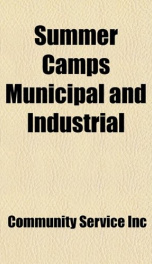summer camps municipal and industrial

Purchase of this book includes free trial access to www.million-books.com where you can read more than a million books for free. This is an OCR edition with typos. Excerpt from book: CHAPTER THREE Camp Administration PLANNING THE CAMP Site. Should be chosen on the advice of an expert with regard to: 1. Sanitation : sloping ground, good distance from marshes and bogs; land not recently disturbed and without "clay soil 2. Water Supply: nearness to spring as the ideal source of supply, or good well, if spring is unavailable. (In the latter case the well must be thoroughly tested by an expert.) 3. Convenience for transportation and the securing of food 4. Particular appropriateness for the kind of camp wanted Buildings. Should be chosen with the following considerations in mind: 1. Number of campers to be accommodated 2. Seasons of the year to be used 3. Temporary or permanent camp 4. Available funds ( Note : A pavilion type of dining-room and a central building for indoor games in rainy weather are requisite in most sections of the country, except in a case where the center is large enough to be used as dining-room in unfavorable weather. Tents or rough shacks furnish sleeping, quarters. The best type of tent is one accommodating four to six people which opens at both ends and with sides which may be rolled up. It should in every case be pitched over a wooden platform floor several inches above the ground. General Equipment 1. Equipment for field sports such as basketball, volley ball, baseball, tennis, etc.obtainable from city playgrounds if not in use 2. Auto or horse for transportation and pleasure. (An auto truck with seats along the sides is ideal.) 3. Row boats and dock, and diving raft,if camp is near lake or river Budget. A sample budget is practically impossible as costs and kinds of camps are so varied. For general statements of expenses see below. 1. Outlay Initial cost of camp and equipm...
Info about the book
Author:
Series:
Unknown
ASIN:
B003OK0FE4
Rating:
4/5 (3)Your rating:
0/5
Languge:
English
Users who have this book
Users who want this book
What readers are saying
What do you think? Write your own comment on this book!
write a commentif you like summer camps municipal and industrial try:
Do you want to exchange books? It’s EASY!
Get registered and find other users who want to give their favourite books to good hands!


